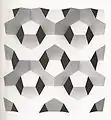Snub trihexagonal tiling
In geometry, the snub hexagonal tiling (or snub trihexagonal tiling) is a semiregular tiling of the Euclidean plane. There are four triangles and one hexagon on each vertex. It has Schläfli symbol sr{3,6}. The snub tetrahexagonal tiling is a related hyperbolic tiling with Schläfli symbol sr{4,6}.
| Snub trihexagonal tiling | |
|---|---|
 | |
| Type | Semiregular tiling |
| Vertex configuration |  3.3.3.3.6 |
| Schläfli symbol | sr{6,3} or |
| Wythoff symbol | | 6 3 2 |
| Coxeter diagram | |
| Symmetry | p6, [6,3]+, (632) |
| Rotation symmetry | p6, [6,3]+, (632) |
| Bowers acronym | Snathat |
| Dual | Floret pentagonal tiling |
| Properties | Vertex-transitive chiral |
Conway calls it a snub hextille, constructed as a snub operation applied to a hexagonal tiling (hextille).
There are three regular and eight semiregular tilings in the plane. This is the only one which does not have a reflection as a symmetry.
There is only one uniform coloring of a snub trihexagonal tiling. (Labeling the colors by numbers, "3.3.3.3.6" gives "11213".)
Circle packing
The snub trihexagonal tiling can be used as a circle packing, placing equal diameter circles at the center of every point. Every circle is in contact with 5 other circles in the packing (kissing number).[1] The lattice domain (red rhombus) repeats 6 distinct circles. The hexagonal gaps can be filled by exactly one circle, leading to the densest packing from the triangular tiling.
Related polyhedra and tilings

| Uniform hexagonal/triangular tilings | ||||||||
|---|---|---|---|---|---|---|---|---|
| Fundamental domains |
Symmetry: [6,3], (*632) | [6,3]+, (632) | ||||||
| {6,3} | t{6,3} | r{6,3} | t{3,6} | {3,6} | rr{6,3} | tr{6,3} | sr{6,3} | |
 |
 |
 |
 |
 |
 |
 |
 |
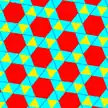 |
| Config. | 63 | 3.12.12 | (6.3)2 | 6.6.6 | 36 | 3.4.6.4 | 4.6.12 | 3.3.3.3.6 |
Symmetry mutations
This semiregular tiling is a member of a sequence of snubbed polyhedra and tilings with vertex figure (3.3.3.3.n) and Coxeter–Dynkin diagram ![]()
![]()
![]()
![]()
![]() . These figures and their duals have (n32) rotational symmetry, being in the Euclidean plane for n=6, and hyperbolic plane for any higher n. The series can be considered to begin with n=2, with one set of faces degenerated into digons.
. These figures and their duals have (n32) rotational symmetry, being in the Euclidean plane for n=6, and hyperbolic plane for any higher n. The series can be considered to begin with n=2, with one set of faces degenerated into digons.
| n32 symmetry mutations of snub tilings: 3.3.3.3.n | ||||||||
|---|---|---|---|---|---|---|---|---|
| Symmetry n32 |
Spherical | Euclidean | Compact hyperbolic | Paracomp. | ||||
| 232 | 332 | 432 | 532 | 632 | 732 | 832 | ∞32 | |
| Snub figures |
 |
 |
 |
 |
 |
 |
 |
 |
| Config. | 3.3.3.3.2 | 3.3.3.3.3 | 3.3.3.3.4 | 3.3.3.3.5 | 3.3.3.3.6 | 3.3.3.3.7 | 3.3.3.3.8 | 3.3.3.3.∞ |
| Gyro figures |
 |
 |
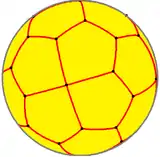 |
 |
 |
 |
 |
 |
| Config. | V3.3.3.3.2 | V3.3.3.3.3 | V3.3.3.3.4 | V3.3.3.3.5 | V3.3.3.3.6 | V3.3.3.3.7 | V3.3.3.3.8 | V3.3.3.3.∞ |
6-fold pentille tiling
| Floret pentagonal tiling | |
|---|---|
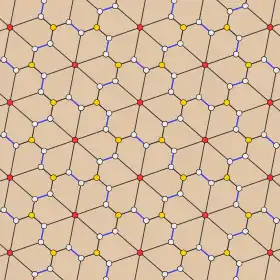 | |
| Type | Dual semiregular tiling |
| Faces | irregular pentagons |
| Coxeter diagram | |
| Symmetry group | p6, [6,3]+, (632) |
| Rotation group | p6, [6,3]+, (632) |
| Dual polyhedron | Snub trihexagonal tiling |
| Face configuration | V3.3.3.3.6 Face figure:  |
| Properties | face-transitive, chiral |
In geometry, the 6-fold pentille or floret pentagonal tiling is a dual semiregular tiling of the Euclidean plane.[2] It is one of the 15 known isohedral pentagon tilings. Its six pentagonal tiles radiate out from a central point, like petals on a flower.[3] Each of its pentagonal faces has four 120° and one 60° angle.
It is the dual of the uniform snub trihexagonal tiling,[4] and has rotational symmetries of orders 6-3-2 symmetry.
Variations
The floret pentagonal tiling has geometric variations with unequal edge lengths and rotational symmetry, which is given as monohedral pentagonal tiling type 5. In one limit, an edge-length goes to zero and it becomes a deltoidal trihexagonal tiling.
| General | Zero length degenerate |
Special cases | |||
|---|---|---|---|---|---|
 (See animation) |
 Deltoidal trihexagonal tiling |
 |
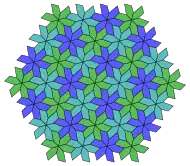 |
 |
 |
 a=b, d=e A=60°, D=120° |
 a=b, d=e, c=0 A=60°, 90°, 90°, D=120° |
 a=b=2c=2d=2e A=60°, B=C=D=E=120° |
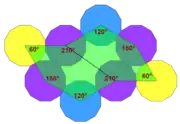 a=b=d=e A=60°, D=120°, E=150° |
 2a=2b=c=2d=2e 0°, A=60°, D=120° |
 a=b=c=d=e 0°, A=60°, D=120° |
Related k-uniform and dual k-uniform tilings
There are many k-uniform tilings whose duals mix the 6-fold florets with other tiles; for example, labeling F for V34.6, C for V32.4.3.4, B for V33.42, H for V36:
| uniform (snub trihexagonal) | 2-uniform | 3-uniform | |||
|---|---|---|---|---|---|
| F, p6 (t=3, e=3) | FH, p6 (t=5, e=7) | FH, p6m (t=3, e=3) | FCB, p6m (t=5, e=6) | FH2, p6m (t=3, e=4) | FH2, p6m (t=5, e=5) |
 |
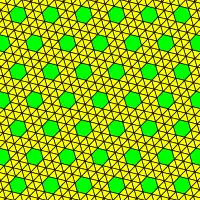 |
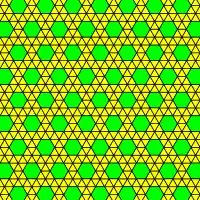 |
 |
 |
 |
| dual uniform (floret pentagonal) | dual 2-uniform | dual 3-uniform | |||
 |
 |
 |
 |
 |
 |
| 3-uniform | 4-uniform | ||||
| FH2, p6 (t=7, e=9) | F2H, cmm (t=4, e=6) | F2H2, p6 (t=6, e=9) | F3H, p2 (t=7, e=12) | FH3, p6 (t=7, e=10) | FH3, p6m (t=7, e=8) |
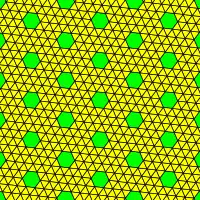 |
 |
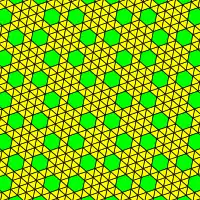 |
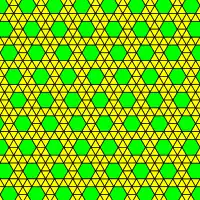 |
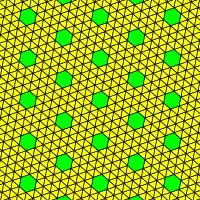 |
 |
| dual 3-uniform | dual 4-uniform | ||||
 |
 |
 |
 |
 |
 |
Fractalization
Replacing every V36 hexagon by a rhombitrihexagon furnishes a 6-uniform tiling, two vertices of 4.6.12 and two vertices of 3.4.6.4.
Replacing every V36 hexagon by a truncated hexagon furnishes a 8-uniform tiling, five vertices of 32.12, two vertices of 3.4.3.12, and one vertex of 3.4.6.4.
Replacing every V36 hexagon by a truncated trihexagon furnishes a 15-uniform tiling, twelve vertices of 4.6.12, two vertices of 3.42.6, and one vertex of 3.4.6.4.
In each fractal tiling, every vertex in a floret pentagonal domain is in a different orbit since there is no chiral symmetry (the domains have 3:2 side lengths of in the rhombitrihexagonal; in the truncated hexagonal; and in the truncated trihexagonal).
| Rhombitrihexagonal | Truncated Hexagonal | Truncated Trihexagonal |
|---|---|---|
 |
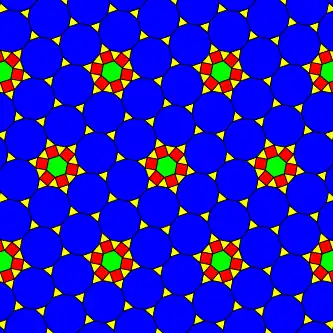 |
 |
 |
 |
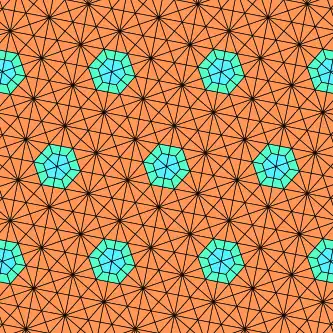 |
See also
References
- Order in Space: A design source book, Keith Critchlow, p.74-75, pattern E
- John H. Conway, Heidi Burgiel, Chaim Goodman-Strass, The Symmetries of Things, 2008, ISBN 978-1-56881-220-5, "A K Peters, LTD. - The Symmetries of Things". Archived from the original on 2010-09-19. Retrieved 2012-01-20. (Chapter 21, Naming Archimedean and Catalan polyhedra and tilings, p. 288, table)
- Five space-filling polyhedra by Guy Inchbald
- Weisstein, Eric W. "Dual tessellation". MathWorld.
- John H. Conway, Heidi Burgiel, Chaim Goodman-Strass, The Symmetries of Things 2008, ISBN 978-1-56881-220-5
- Grünbaum, Branko; Shephard, G. C. (1987). Tilings and Patterns. New York: W. H. Freeman. ISBN 0-7167-1193-1. (Chapter 2.1: Regular and uniform tilings, p. 58-65)
- Williams, Robert (1979). The Geometrical Foundation of Natural Structure: A Source Book of Design. Dover Publications, Inc. ISBN 0-486-23729-X. p. 39
- Keith Critchlow, Order in Space: A design source book, 1970, p. 69-61, Pattern R, Dual p. 77-76, pattern 5
- Dale Seymour and Jill Britton, Introduction to Tessellations, 1989, ISBN 978-0866514613, pp. 50–56, dual rosette tiling p. 96, p. 114






